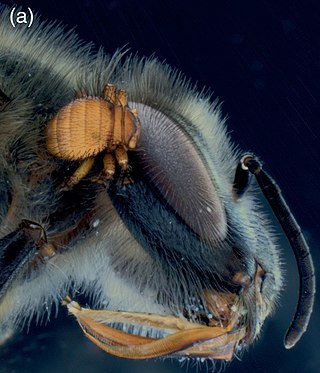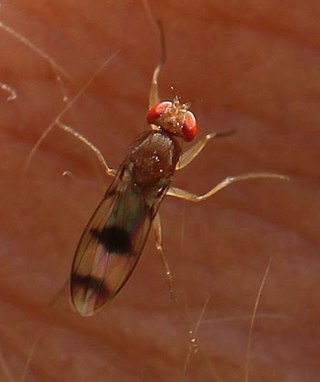
The Drosophilidae are a diverse, cosmopolitan family of flies, which includes species called fruit flies, although they are more accurately referred to as vinegar or pomace flies. Another distantly related family of flies, Tephritidae, are true fruit flies because they are frugivorous, and include apple maggot flies and many pests. The best known species of the Drosophilidae is Drosophila melanogaster, within the genus Drosophila, also called the "fruit fly." Drosophila melanogaster is used extensively for studies concerning genetics, development, physiology, ecology and behaviour. Many fundamental biological mechanisms were discovered first in D. melanogaster. The fruit fly is mostly composed of post-mitotic cells, has a very short lifespan, and shows gradual aging. As in other species, temperature influences the life history of the animal. Several genes have been identified that can be manipulated to extend the lifespan of these insects. Additionally, Drosophila subobscura, also within the genus Drosophila, has been reputed as a model organism for evolutionary-biological studies, along with D. sechellia for the evolution of host specialization on the toxic noni fruit and Scaptomyza flava for the evolution of herbivory and specialist on toxic mustard leaves.

Braulidae, or bee lice, is a family of true flies (Diptera) with seven species in two genera, Braula and Megabraula. They are found in honey bee colonies due to their phoretic, inquiline, and kleptoparasitic relationships with the bees. Similar in appearance but not closely related to keds, these flies are also small, wingless, and occasionally mistaken for mites or lice, hence their common name.

Carnoidea is a superfamily of Acalyptratae flies.

Xylomyidae is a family of flies known commonly as the wood soldier flies. They are xylophagous and are associated with dead or dying wood.

Platypezidae is a family of true flies of the superfamily Platypezoidea. The more than 250 species are found worldwide primarily in woodland habitats. A common name is flat-footed flies, but this is also used for the closely related Opetiidae which were formerly included in the Platypezidae.
Syringogaster is a genus of small ant-mimicking flies with a petiolate abdomen, a long prothorax, a swollen and spiny hind femur, and reduced head size and large eyes. There are 20 described extant species and two species known from Miocene amber from the Dominican Republic. It is the only genus in the family Syringogastridae.

Atelestidae is a family of flies in the superfamily Empidoidea. The four genera were placed in a separate family in 1983; they were formerly either in Platypezidae or considered incertae sedis. While they are doubtless the most basal of the living Empidoidea, the monophyly of the family is not fully proven. The genus Nemedina seems to represent a most ancient lineage among the entire superfamily, while Meghyperus is probably not monophyletic in its present delimitation, and it is liable to be split up eventually, with some species being placed elsewhere. In 2010, the genus Alavesia, previously only known from Cretaceous fossils, was found alive in Namibia, subsequent species were also described from Brazil.

Acrocerinae is a subfamily of small-headed flies in the family Acroceridae. Their larvae are endoparasites of araneomorph spiders, with the exception of Carvalhoa appendiculata which can develop as ectoparasitoids on their host spiders. Traditionally, the subfamily included the genera now placed in Cyrtinae and Ogcodinae, but the subfamily in this sense was found to be polyphyletic and was split up in 2019.

The Diadocidiidae are a family of flies (Diptera), containing one extant genus with over 20 species and one extinct genus. Diadocidiidae are found worldwide, except in Africa and Antarctica. They are usually considered close to the Keroplatidae, Bolitophilidae, and Ditomyiidae, and used to be included in the Mycetophilidae. They are woodland flies, found in shaded places in forests or near streams. The larvae spin silken tubes under bark or in dead logs, and feed on hymenium of Polyporaceae fungi. The average body length for adults is around 2.5–5.6 mm.
There are various disparate groups of wingless insects. Apterygota are a subclass of small, agile insects, distinguished from other insects by their lack of wings in the present and in their evolutionary history. They include Thysanura . Some species lacking wings are members of insect orders that generally do have wings. Some do not grow wings at all, having "lost" the possibility in the remote past. Some have reduced wings that are not useful for flying. Some develop wings but shed them after they are no longer useful. Other groups of insects may have castes with wings and castes without, such as ants. Ants have alate queens and males during the mating season and wingless workers, which allows for smaller workers and more populous colonies than comparable winged wasp species.

Hirtodrosophila is a genus of fruit flies from the family Drosophilidae. Originally Hirtodrosophila was a subgenus of the genus Drosophila. It was raised to the status of genus by Grimaldi in 1990.

Scatopsoidea is a superfamily of true flies that comprises the families Canthyloscelidae, Scatopsidae, and Valeseguyidae. There are about 400 known species worldwide but more may yet to be discovered, especially in the tropics.
Apystomyia is a genus of flies in the family Apystomyiidae. The genus contains the single living Apystomyiidae species, Apystomyia elinguis, which is primarily found in California. Details of its life history are largely unknown. The extinct genus Hilarimorphites is known from the Cretaceous Burmese and New Jersey ambers. Formerly placed in the Asiloidea, molecular phylogenetic studies in 2010 placed the genus unambiguously as a sister of the Cyclorrhapha within the clade Eremoneura.

Cyamops is a genus of flies.

New Jersey Amber, sometimes called Raritan amber, is amber found in the Raritan and Magothy Formations of the Central Atlantic (Eastern) coast of the United States. It is dated to the Late Cretaceous, Turonian age, based on pollen analysis of the host formations. It has been known since the 19th century, with several of the old clay-pit sites now producing many specimens for study. It has yielded a number of organism fossils, including fungi, plants, tardigrades, insects and feathers. The first identified Cretaceous age ant was described from a fossil found in New Jersey in 1966.

Chymomyza is a genus of vinegar flies.

Lygistorrhininae, commonly called long-beaked fungus gnats is a subfamily of flies in the Diptera family Keroplatidae. The groups was long treated as a separate family, but molecular phylogenetic analysis has shown it to belong to Keroplatidae. There are about 7 genera and at least 30 described species in Lygistorrhininae.
Microphorites is an extinct genus of flies in the family Dolichopodidae.
Valeseguyidae is a family of flies, belonging to Scatopsoidea. It contains only one known extant species, Valeseguya rieki, known from a single male specimen found in Victoria, Australia, described in 1990. It was initially classified as a member of the wood gnat family Mycetobiidae, but was later given its own family in 2006. Two fossil species are known, including another species of Valeseguya, V. disjuncta, which is known from Miocene aged Dominican amber from the Caribbean, and Cretoseguya, containing the single species C. burmitica, which is known from the mid-Cretaceous Burmese amber of Myanmar, dating to around 100 million years ago.














